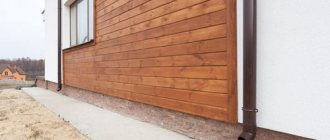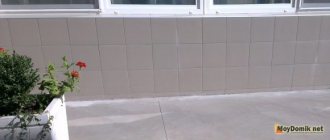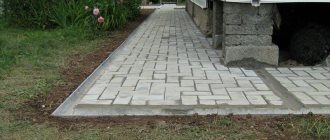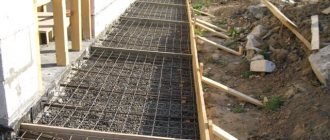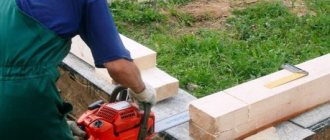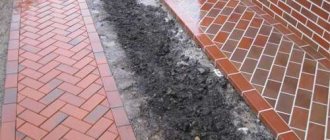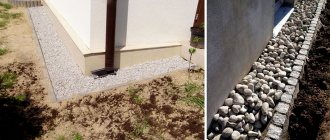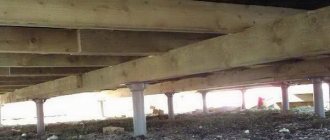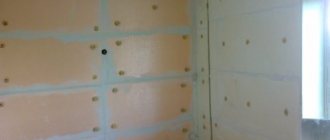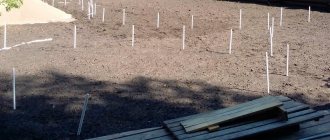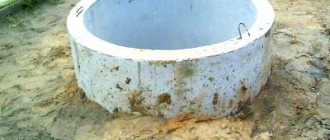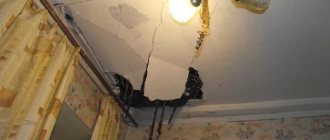General arrangement of the blind area around the house
The blind area is necessary to protect the foundation from the negative effects of water and snow. General requirements: strength, insulation and waterproofing. Functions of the blind area:
- Drainage of water from the basement of the house. Constant exposure to moisture destroys the integrity of concrete and it begins to crumble.
- Prevent soil movement. The blind area helps reduce the pressure on the building that occurs as a result of shifts in soil layers.
- Maintaining temperature conditions. To do this, the horizontal protective strip around the house is insulated.
- Improving the appearance of the building. The blind area makes the facade of the house more harmonious and complete.
The optimal width of the blind area is 100 cm. The concrete surface will not only drain water from the walls, but will also act as a path. The depth level is calculated individually. Calculations should be made based on the level of soil freezing in winter. Underground communication systems have a direct impact on the depth of soil freezing. Minimum thickness – 7-10 cm.
Creating a blind area
When you have figured out the best way to insulate the blind area, you should find out what it consists of and how to make it yourself. First, let's look at what the general scheme for creating a soft and hard blind area looks like, and then consider the installation of all types of insulation.
We suggest you read: How to insulate a steam room in a brick bathhouse
The step-by-step instructions are as follows:
- You need to drive pegs around the house and pull a string between them so that you can mark the area for the blind area. A trench should be dug along the cord. We already talked about the width above, but the depth will directly depend on the type of soil. If the soil is clayey, a depth of 45 cm is enough. On loose soil, the depth should be 60 cm so that the clay castle can be laid.
- After this, the formwork should be installed around the trench and the laying of layers can begin. If making a clay castle is required, make it the first layer. We pour the clay to a thickness of 10-25 cm, this is selected individually according to the condition of the soil. The layer needs to be leveled, compacted tightly, and done so. To create a slight slope from the foundation.
- The next layer is sand, its thickness should be from 5 to 10 cm.
- Lay a waterproofing film on the sand and wrap it over the base.
- Now you need to lay the insulation yourself. We lay the selected insulation material on top of the waterproofing. If you also want to insulate the base, then do this together with insulating the waterproofing.
- There should be another layer of waterproofing on top of the insulation, and then cover everything again with a layer of sand of the same thickness as the first time.
- Now place a geotextile fabric on the sand, which will prevent mixing of the two layers, and if you are making a soft insulated blind area, it will play the role of a water filter. Place 10 cm of medium-fraction crushed stone on the geotextile.
- If you are making a soft blind area, pour 5 cm of sand on top of the crushed stone and paving stones or ordinary decorative stone on top.
- To make a concrete blind area with your own hands, lay a reinforcing mesh on the crushed stone, with cells measuring 10*10 cm every 3 to 6 meters, and also install boards edgewise on the bends and corners. They are required in order to create expansion joints that will protect the screed from cracking. In addition, the correctly selected height of the boards will also become a good beacon when pouring the screed.
- Pour the concrete solution in one day. When the screed begins to harden, but is a little damp, dry cement should be rubbed over it and covered with plastic wrap. These actions will give the concrete strength and reduce the level of water permeability.
- Finish the top of the completely cured screed. This could be asphalt, paving slabs, stone or other material of your choice.
So, we have looked at the general scheme for creating a screed cake. Now let's find out what is included in the step-by-step installation instructions for each of the proposed types of thermal insulation.
By the way, for the correct preparation of concrete for screed, you can find the required proportions in the plate.
| Brand | Mass composition, C*P*SH (kg) | Composition by volume per 10 liters of cement, P*Shch (l) | Amount of concrete per 10 liters of cement, (l) |
| M100 | 1*4,65*7 | 42*62 | 79 |
| M150 | 1*3,55*5,75 | 33*51 | 65 |
| M200 | 1*2,85*4,85 | 24*41 | 55 |
| M250 | 1*2,15*3,95 | 20*35 | 44 |
| M300 | 1*1,95*3,75 | 18*33 | 42 |
| M400 | 1*1,25*2,75 | 12*25 | 32 |
| M450 | 1*1,15*2,55 | 11*23 | 30 |
In what cases is it necessary to insulate the blind area?
There are a number of cases when it is recommended to insulate the blind area. This is necessary not only to reduce heat loss, but also to reduce the depth of foundations.
Improving performance and reducing heat loss
Sometimes there is a need to turn a basement or basement into a heated room. To reduce heat loss, it is recommended to insulate the blind area. This simple method will reduce the cost of heating the basement. An insulated blind area will help insulate the walls of the basement and the floors of the first floor.
Materials used
From the existing options, you can choose the appropriate option for insulating the blind area.
Expanded clay
Expanded clay blind area
Expanded clay insulation is a traditional option. This material is environmentally friendly, so it does not harm the environment or the residents of the house. It has excellent heat-insulating properties, which largely depend on the fraction of the material - it can be sand, crushed stone or gravel.
Gravel is an ideal heat insulator - it tolerates frost well, but needs protection from moisture, so arranging the blind area involves constructing a drainage system. The fact is that when it is moistened, expanded clay loses its heat-insulating ability, so it is necessary to lay pipes around the perimeter of the house that will drain into the water.
It looks like this: the dug hole is lined with geotextile and covered with crushed stone, followed by the laying of drainage pipes, which are also covered with crushed stone and covered with the ends of the geotextile fabric. After this, the trench remains to be filled with sand.
Styrofoam
Insulation of the blind area with foam plastic
Polystyrene foam is a fairly common thermal insulation material that has low thermal conductivity, frost resistance, light weight and ease of installation.
But the low strength of such a material implies the need for reinforcement of heat insulator plates, which should be taken into account when calculating the cost of foam insulation.
Polyurethane foam
When insulating a blind area with polyurethane foam, homeowners will encounter certain difficulties, since they will have to order a special machine for its installation. It is also impossible to do without the help of a professional, since the use of such special equipment requires appropriate work skills. However, this material has many advantages:
- Low thermal conductivity;
- Water-repellent properties;
- Protected from biological influences;
- Can be applied at any temperature;
- Non-flammable;
- There are no cracks or joints.
Insulation of the blind area with penoplex
Penoplex insulation is the most popular option; the following advantages should be taken into account:
- It tolerates low temperatures well;
- It is light in weight;
- Non-flammable, does not ignite easily;
- Good water-repellent characteristics;
- Long service life.
For insulation purposes, 10 cm thick slabs are used; if the slab is 5 cm thick, then they will have to be laid in two rows. It is important to ensure a tight connection of the joints, which is achieved through a special film.
- Excavation. At this stage, it is necessary to dig a trench and remove large rhizomes from it. We dig a trench to the width of the roof overhang plus 20-30 cm. To avoid destruction of the foundation protection by roots in the future, we treat the ground with herbicides.
- Drainage device. To drain water from the ground around the home, we install a drainage layer. To do this, pour a layer of crushed stone into the trench, first providing a clay substrate made of rich clay. The lower the density of the soil, the larger the layer of clay that needs to be placed to avoid pushing through the structure. Also, a layer of sand can be placed on top of the clay before filling with crushed stone - each layer of bulk materials should be 10-15 cm wide.
- Laying insulation. Having decided on the thermal insulation material, we lay it on a layer of gravel. If it is expanded clay, then we simply pour the crushed stone into the trench. If we choose sheet materials, then we need to take care of waterproofing the joints of the plates. If necessary, we arrange reinforcement for the heat insulator if the material is fragile.
- Waterproofing device. The presence of this layer is also determined by the selected material. For example, expanded clay does not need waterproofing, but expanded polystyrene or polystyrene foam must be covered with a layer of roofing material or polyethylene. Such materials are joined at joints with an overlap of up to 20 centimeters.
- Finishing. The finishing layer is laid on a waterproofing layer - it can be concrete, tiles or crushed stone, which gives the blind area a finished look.
Tags: around, blind area, insulate
« Previous entry
Materials used for warm blind area
To insulate the blind area, a variety of building materials are used. This can be expanded clay, polystyrene foam, polyurethane foam and penoplex. Each of the materials has its own advantages and disadvantages.
Blind area with expanded clay
Expanded clay is a cheap and environmentally friendly building material. For its production, clay is used, which is processed at high temperatures. The material has good density and low water absorption.
To obtain the desired effect, the expanded clay layer must be larger than the layer of any other insulation. The size of the fraction is of great importance. Large granules have high thermal insulation properties. For insulation, it is best to use this type of expanded clay. However, the fine fraction is more durable and dense. During installation, the insulation is laid on high-density polyethylene or ribbed material.
Foam insulation
Polyfoam does not absorb moisture and has good waterproofing properties. Most of the insulation structure is air, therefore it has low thermal conductivity and a high level of sound absorption. These indicators are especially important if the house has a basement.
Thermal insulation of the basement
Now let's talk about how to properly insulate the blind area of a house. Installing insulation inside is not difficult, but take it seriously. In most cases, this is what insulation was started for. Although, if we are talking about the complexity of the work, then you can insulate the blind area with expanded clay or expanded polystyrene with your own hands, but to spray polyurethane you will need to contact specialists.
Insulation with a material such as polystyrene foam is done using sheets of material with a thickness of 10 cm in one layer. If you use sheets with a thickness of 5 cm, you should lay them in two layers. In this case, the slabs of the top row must overlap the joints on the bottom row. Fill all gaps with pieces of insulation or blow out with foam. The installed thermal insulation around the house must have the appearance of a monolithic structure.
In this case, the installation scheme is slightly different:
- In a soft blind area, the slabs should be laid between two layers of sand, which will protect the slabs and waterproofing from damage due to crushed stone.
- Insulation of a hard type blind area should be done in two ways, which differ by pouring concrete. In the first option, the insulation is placed between two layers of sand, and crushed stone is sprinkled on top, a reinforcing mesh and a concrete screed are laid. With the second method, the concrete screed can be poured directly onto the insulation. It will also need to be covered with waterproofing, and reinforcement rods should be placed on top, perpendicular to the foundation, in increments of 60 cm. Reinforcing mesh is laid on top of them and filled with concrete mortar.
In this case, the step-by-step instructions remain unchanged, since the plates are made of similar material. But the fact is that a blind area with penoplex or polystyrene foam will last several times less than with expanded polystyrene.
Polyurethane foam
This is the most effective, but expensive insulation of the blind area. It is applied under high pressure, and therefore a layer of crushed stone should be laid on the sand before spraying begins, otherwise the sand will simply blow away. The foam should be applied to crushed stone with a thickness of 7 cm. After ¼ hour it will harden completely and will be ready for you to lay the reinforcing mesh and then pour the concrete screed.
We invite you to read: Do-it-yourself soft blind area step-by-step instructions
Expanded clay
The easiest way to insulate a foundation blind area is to use expanded clay. The pie diagram is like this:
- At the bottom of the trench, arrange a clay castle, which will be covered with a layer of waterproofing material.
- Afterwards, you should pour a layer of sand, which will be covered with dronite. Such material will protect the structure from subsidence in the future.
- Cover the material with a layer of expanded clay, then cover it again with a layer of dronite, and pour sand on top of it.
So we have the simplest insulation with expanded clay, which you can do yourself. Place decorative crushed stone on top of the sand around the house or make any other covering of your choice.
In any case, the installation process is simple. The only caveat is that the option with polystyrene foam involves laying waterproofing between it and the wall. In the center and in the corners, for reliability, the slabs should be fixed using plastic umbrella dowels. After this, you can begin finishing work. Usually. A mesh is glued onto the slabs, a layer of primer is applied and covered with decorative plaster.
This, perhaps, is all about how to insulate the blind area and foundation yourself.
